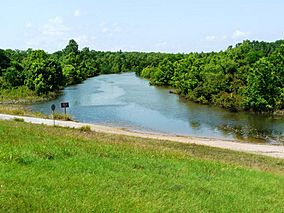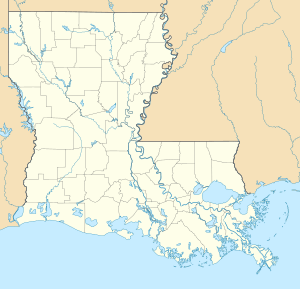Cat Island National Wildlife Refuge facts for kids
Quick facts for kids Cat Island National Wildlife Refuge |
|
|---|---|
|
IUCN Category IV (Habitat/Species Management Area)
|
|
 |
|
| Location | West Feliciana Parish, Louisiana, United States |
| Nearest city | St. Francisville, Louisiana |
| Area | 9,623 acres (38.9 km2) |
| Established | 2000 |
| Governing body | U.S. Fish and Wildlife Service |
| Website | Cat Island National Wildlife Refuge |
Cat Island National Wildlife Refuge is a special place in Louisiana, USA. It was created on October 27, 2000. This refuge is near St. Francisville, Louisiana, about 30 miles (48 km) north of Baton Rouge. Its main goal is to protect and restore natural wetlands and forests. These areas are home to many migratory birds, fish, and other wildlife. Some of these animals are even endangered or threatened. The refuge also helps people learn about nature and encourages volunteers to join in conservation efforts.
How Cat Island Refuge Was Created
In 2000, a group called The Nature Conservancy of Louisiana bought the land. This land later became the Cat Island National Wildlife Refuge. The United States Fish and Wildlife Service slowly took over the land. By 2003, the refuge grew to its current size of 9,623 acres (38.9 km2).
Amazing Nature at Cat Island
Cat Island National Wildlife Refuge is located along the southern part of the Mississippi River. This area often floods each year because there are no levees. The refuge is home to many different animals. One important animal living here is the Louisiana black bear. This bear is a federally protected species.
The Mississippi River is like a superhighway for birds. Many migratory birds fly through this area. This includes the swallow-tailed kite, which is a bird of special concern. Other animals you might see include white-tailed deer, bobcats, minks, and river otters. You can also find wild turkeys, wood ducks, and many other birds. Frogs like the green tree frog and turtles like the red-eared slider also live here.
The refuge has several types of forests and swamps. One very special part is an old-growth area. This forest has ancient baldcypress and tupelo trees. Many of these baldcypress trees are thought to be 500 to 1,000 years old!
The refuge is also home to the National Champion baldcypress. This is the largest tree of any kind east of the Sierra Nevada mountains. You can find this giant tree about 4.8 miles (7.7 km) from the refuge entrance.
Visiting Cat Island Refuge
The refuge can be flooded by the river, usually from January to June. You can drive into the refuge when the Mississippi River is not too high. This is measured by a gauge in Baton Rouge. If the gauge reads under 26 feet (7.9 m), you can usually drive in.
There are gates along the road that open and close depending on the water level. You cannot reach the National Champion baldcypress tree if the Baton Rouge gauge reaches 26 feet (7.9 m). All car access to the refuge stops when the gauge reaches 31 feet (9.4 m).



